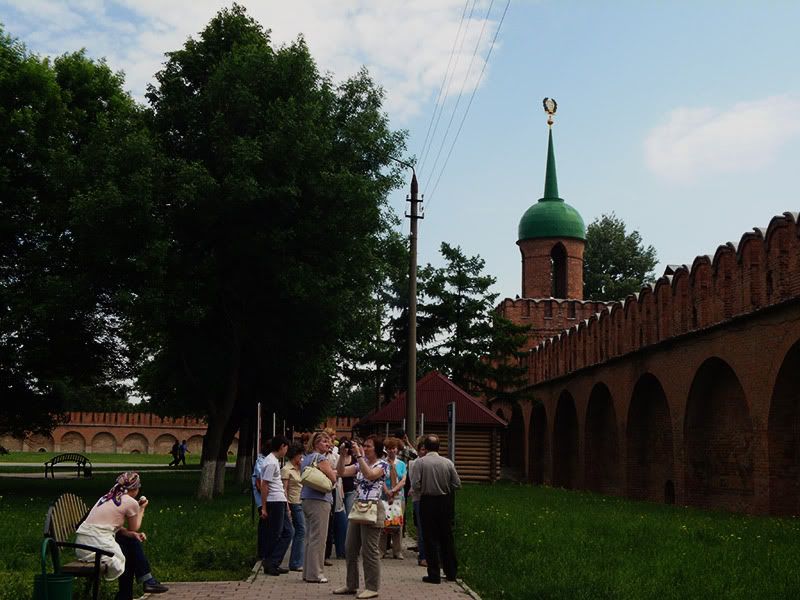阳光水世界沙县小吃:图拉俄罗斯国立武器博物馆
来源:百度文库 编辑:偶看新闻 时间:2024/05/05 19:56:19
Tula Arms Plant (or ) is a Russian weapons manufacturer founded by Tsar Peter I of Russia in 1712[1] in Tula, Russia as Tula Arsenal. Throughout history, it has produced weapons for whoever controlled the Russian state. Its name changed from Tula Arsenal to Tula Arms Plant during the Soviet era.
Tula was strategically important to the Soviet Union during the Cold War. Significant ore deposits were situated relatively close to it and it had access to ample transportation routes like the Upa River and many rail lines coming into and out of the city.
During World War II, the German army invaded Russia as part of Operation Barbarossa. By December 5, the German 2nd Panzer Division had advanced to within a few kilometers of Tula, forcing the Soviets to abandon Tula Arms Plant. As a result, far fewer weapons were produced there than at other Soviet factories such as Izhevsk Mechanical Works. Consequently, Tula weapons of World War II are considered more valuable by collectors.
Tula is most known for manufacturing the VSS Vintorez, AS Val, and TOZ rifle weapons designed by TsNIITochMash. During the Soviet era, Tula Arms Plant produced other military rifles, including the Mosin-Nagant, AK-47, and SKS. It also was a major producer of the M1895 revolver.


俄罗斯总统梅德维捷夫参观国立武器博物馆,2009年3月11日。


Russian town Tula was known for many years through history for a few things were told to be the best if bought from Tula.
Those were “samovars” - Russian giant tea pots, “pryaniki” - Russian gingerbread and “pushka” - Russian cannons as well as many more Russian small arms, like rifles for example. With the coming of modern times most of the traditional crafts become more and more forgotten but still they have some weapon factories and gingerbread bakeries there, so the legend still lives somehow.
That’s why one of the first points of interest which tourists have in Tula is arms museum
图拉国家武器博物馆(Tula State Museum of Weapon )
Tula has been making arms since the stone age, in 1712, Tula was visited by Peter the Great, who commissioned the Demidov blacksmiths to build the first armament factory in Russia. Today there is an arms museum in one of the two remaining buildings of Tula's Kremlin and it is a interesting museum with a lot to see. There is a collection of miniature pistols that actual can fire. There is a bolt action rifle you have to look through a microscope to see it, it is an actual firing weapon and also a fea with horseshoes on its feet. I tried to tale photos of these exhibits, and they were not as good as I had hoped, but I did buy two photos of the miniature rifle and fea with horseshoes. JD

1989年图拉国家武器博物馆就在这个教堂中开馆布展。







dueling pistol set
pepperboxes
lever actions
Gatlin gun,加特林机枪。


















































1983 Tula AKS-74U Marshall Arms AKSU SBR

The PP-90M1 submachine gun is the latest development of the Tula-based
The PP-90M1 submachine gun is the latest development of the Tula-based famous KBP design bureau. It is a completely new development, despite its designation, that could misleadingly suggest that it is a derivative of the PP-90 and PP-90M folding clandestine machine guns. PP-90M1 could be described as a more modern rival to the "Bizon" PP-19 submachine gun, made in Izhevsk. It is intended to provide compact and lightweight police weapon that could lay serious amount of fire, thanks to its large-capacity helical magazine (similar in basic concept and design to "Bizon" and Calico submachine guns magazines). The most interesting part about PP-90M1 is, however, that it also could be fitted with adapter and then use typical box magazines, which are lighter, have slimmer profile and 1/2 capacity of standard helical magazine. It is not yet known if PP-90M1 is in use with any major law enforcement or security force in Russia.
PP-90M1 is a conventional blowback operated, selective fired machine gun. The gun housing is made entirely from plastic, including integral pistol handle and trigger guard. The top-folding buttstock is made from stamped steel. Safety / fire mode selector is located at the left side of the gun, above the trigger. The charging "button" is located just above the muzzle and should be pressed with one finger (not that easy to do so!) to retract the bolt. It is also unsafe, in my opinion, and mounting of silencer will interfere with charging, too. Weird! Another strange, if not weird, thing is the field stripping. To disassemble the PP-90M1, one must screw out the long disassembly screw, located above the magazine. This requires no tools, but can take about 20-30 seconds. When screw is gone, you then can took the barrel, bolt and return spring out of the gun by pulling it forward.
Feeding is from helical magazines of large capacity, or from typical box magazines, using detachable adapter, which also serves as a forearm. Helical magazines are made from plastic (mostly), while box magazines are made from sheet metal. The PP-90M1 is strong enough to routinely fire powerful Russian-made 9x19mm ammo with armour piercing bullets, 7N21 and 7N31, which is about 9mm +P+ or even +P++ class in the terms of barrel pressure. Any military or commercial 9x19mm ammo can be fired from PP-90M1 safely as well.

Arsenals - Ishevsk, Tula PE/PEM used a longer scope using optics initially

infernal collection from Tula RPG-18 Mukha RPG-26 Aglen' RPG-27 Tavolga

图拉兵工厂

彼得大帝 - 图拉兵工厂的奠基人。